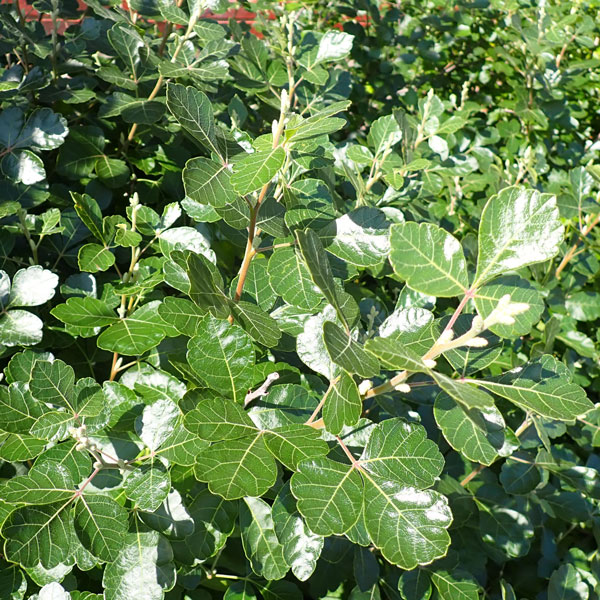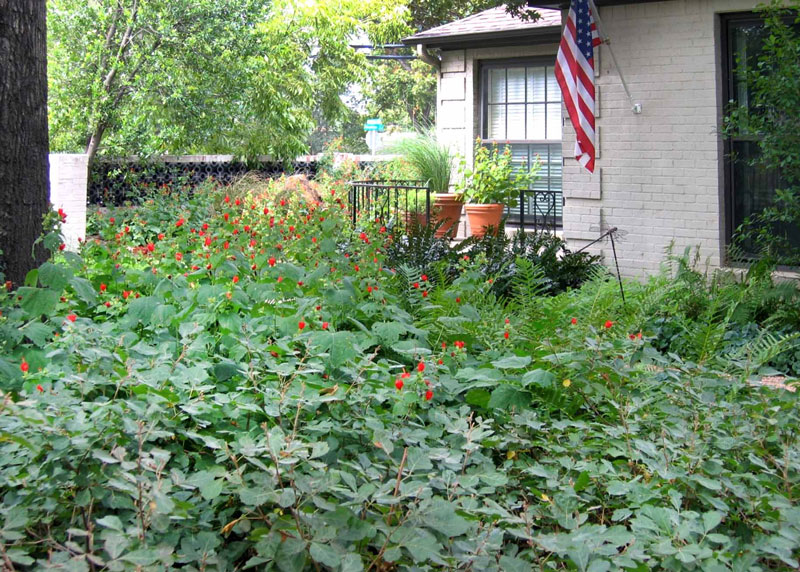Fragrant sumac ‘Gro-low’ – by Steve Huddleston
Aromatic, or fragrant sumac is a beautiful deciduous shrub whose natural range extends throughout Texas. In East Texas it always grows in thickets. In West Texas, individual plants are often found, although long thickets sometimes grow on sandy ridges.
It’s a dense, low-growing, mounding shrub that forms these thickets by root suckers and even when stems root when they touch the ground.

Its glossy leaves are attractive. They’re trifoliate (three leaflets), and the terminal leaflet is longer than the two lateral leaflets. They are green to bluish-green, coarsely toothed, or lobed, on the margins, and fragrant upon being crushed. In the fall, they turn beautiful hues of orange, red and burgundy before dropping.
Separate male flowers (catkins) and female flowers (panicles) appear on the same plant or, more commonly, on different plants. These rather inconspicuous, yellowish-green flowers appear in March or April and last about two weeks. Female flowers give way in late summer to clusters of small red berries (drupes) that may persist into winter. The fruit is attractive to wildlife.

On to today’s Star of the Show…
‘Gro-Low’ is a cultivar of Rhus aromatica that fits beautifully into the home landscape whether it’s a native landscape or not. It makes a tough, fast-growing ground cover that reaches a height of 2 ft. and a width of 6 to 8 ft.
‘Gro-Low’ looks best in a mass planting.
It performs well on slopes or banks, and it helps hold the soil to prevent erosion.
It also makes a good spreading shrub beneath low windows and under trees.
Use ‘Gro-Low’ in a wildscape, butterfly/pollinator garden, xeriscape, or nighttime garden.
Plant ‘Gro-Low’ 4 to 6 ft. apart in full sun to partial shade in any kind of soil as long as it’s well drained.
Do not shear this shrub/groundcover into a formal shape. Let it assume its natural mounding growth form.
This plant has no serious insect or disease problems. It may be susceptible to leaf spots, rust, and nipple galls. The galls will cause small bumps, but they are harmless.

Here’s what you’ll want to know…
• Botanical name is Rhus aromatica ‘Gro-Low.’
• Belongs to the Anacardiacea family, commonly known as the cashew or sumac family. This family consists of flowering plants that produce fruits known as drupes.
• Native to eastern Canada, northeast to central and southern US, and Mexico.
• Hardy in USDA Plant Hardiness Zones 3a-9b, which certainly includes all of Texas.
• The shrub provides cover for birds and small mammals. The flower nectar attracts butterflies and Luna moths. Small mammals like raccoons and possums feed on the berries.
• Tolerates rabbits, drought, erosion, clay soil, dry soil, and shallow, rocky soil.
• Native Americans used the roots of the species to make a yellow dye and berries to make beverages.
• Yes, as all university and botanical garden websites will tell you, it is a sister to poison ivy but do note that they also tell you it is absolutely not poisonous!
